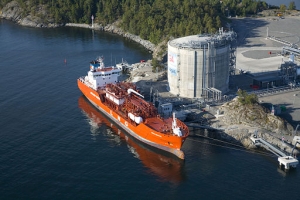Clean Energy Canada | LNG projects should stand on their own two feet, assuming they can
June 5, 2024

Energy and Natural Resource Minister Jonathan Wilkinson was recently quoted as saying that the federal government is “not interested” in subsidizing future liquefied natural gas (LNG) projects.
This should come as no surprise given his government’s commitment to end fossil fuel subsidies by last year. What is interesting, however, is Wilkinson’s U-turn from advocating accelerating Canadian LNG projects and extolling the climate benefits of Canadian LNG just two years ago, to forewarning today of the risk of stranded assets in the face of new LNG facilities coming online in the coming years.
So what’s changed? Cynics might conclude that the feds are experiencing buyer’s remorse from the staggering $34-billion it has cost to complete the Trans Mountain pipeline expansion, and are not eager to repeat the experience. The more mundane truth is that the economics of LNG are increasingly unfavourable.
By 2030, 43 per cent more LNG capacity will have come onstream globally, fighting for market share in an environment in which future demand for LNG is highly uncertain. In addition to oversupply, costs are another strike against Canadian LNG. For Asian countries, the overall cost of purchasing LNG from Qatar is expected to be around 40 per cent below purchasing LNG from British Columbia once delivery costs are factored in.
Adding to Canadian future LNG woes are the rapidly evolving energy systems in our preferred destination markets. To Canada’s west, China is looking to become an LNG exporter to capitalize on its LNG oversupply situation. Meanwhile, Japan’s LNG imports fell by eight per cent in 2023 to the lowest levels seen since 2009, following a restart of the country’s nuclear program, and increased use of renewables. To the east, Canada’s LNG export dreams to the European Union are crumbling as the United States is set to fully replace Russian LNG imports in the long term.
Canada’s LNG industry is correct that our resource has a lower carbon intensity than our competitors’ that could warrant a price premium for markets concerned about their greenhouse gas emissions. However, the reality is that global LNG markets are migrating from developed nations to developing countries that have less capacity or inclination to pick and choose their supply based on carbon footprint.
Looming large over global LNG markets is its biggest threat: renewable energy. Fully 30 per cent of the world’s electricity generation is now from renewables, and it’s increasing faster than anyone imagined. The U.S. has reached its 2025 renewables target a year early. The EU’s economy was forecast to contract without Russian gas, and—due in large part to ambitious buildout of renewables—instead the opposite has happened. Wind and solar energy have now overtaken natural gas in EU electricity production. Last year, China met all of its electricity demand growth through renewables, moving the country six years ahead of schedule on its 2030 pledges.
This is because the viability of renewables has skyrocketed, with grid-scale battery storage costs having declined more than 80 per cent over the past 11 years. Here in Canada, renewables are cost competitive with natural gas electricity generation even when you add the costs of battery storage to offset that intermittency.
It’s not all doom and gloom for Canada’s LNG industry. LNG Canada’s Phase 1 facility in Kitimat, B.C., will become operational next year, with long-term contracts in place. Woodfibre LNG in Squamish, B.C., is under construction with a completion date ahead of 2030. These projects should be able to seize a limited LNG window of opportunity.
Projects not currently under construction, however, face an ever-increasing uphill battle on competition and cost that the taxpayer shouldn’t be asked to underwrite. While the federal government has made the right move, it remains to be seen whether B.C.—which has committed to removing inefficient fossil fuel subsidies—will follow suit.
What we choose to invest in is as much a choice to not invest in something else. There are more promising opportunities worthy of our limited resources.
This post was co-authored by Rachel Doran and originally appeared in The Hill Times.